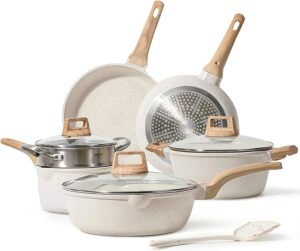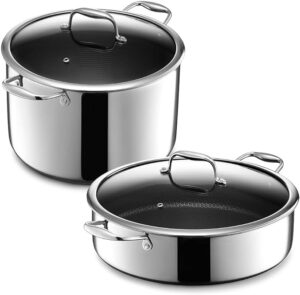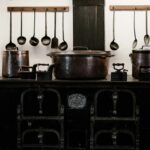2024 Great Kitchen Debates: Simmering or Boiling?

Ah, the kitchen. A place of creativity, comfort, and sometimes chaos. Whether you’re a seasoned chef or a novice cook, there’s one debate that has probably simmered (pun intended) in your mind at some point: simmering or boiling? This is one of those fundamental questions that can make or break your culinary creations.
Table of Contents
Let me take you back to my early days in the kitchen. I remember the first time I tried to make pasta. I was about 12, full of confidence and cluelessness. I filled the pot with water, cranked the stove up to high, and waited. Soon, the water was bubbling away furiously. My mom walked in and casually mentioned, “You know, you don’t always need to boil it like a witch’s cauldron. Sometimes, simmering works better.”
That was my first lesson in the delicate dance between simmering or boiling. It turns out, there’s a lot more to it than just a choice of words.
Simmering: The Gentle Giant
Simmering is the quieter, gentler sibling of boiling. It’s like the difference between a leisurely Sunday drive and a high-speed chase. When you simmer, you cook your food just below the boiling point, usually around 180-200°F (82-93°C). Tiny bubbles occasionally break the surface, but there’s no frantic activity.
Why is simmering so special? Let’s look at some facts:
– Flavor Infusion: Simmering*l allows flavors to meld beautifully. Think about a hearty beef stew. If you boil it, the meat becomes tough, and the flavors don’t have time to develop. But if you simmer it for hours, the result is a tender, flavorful masterpiece.
- Texture Control: Simmering is ideal for delicate foods. Have you ever boiled fish? It disintegrates into a watery mess. Simmering, however, cooks it gently, preserving its texture and flavor.
I learned this lesson the hard way when I decided to make coq au vin for a dinner party. Impatient as ever, I tried to rush the process by boiling the chicken and wine. The result? A disaster. The chicken was tough, and the sauce was a mess. It was only later, when I learned to properly simmer, that I achieved that rich, deep flavor that coq au vin is famous for.
Boiling: The Bold and the Boisterous
Boiling, on the other hand, is all about high energy. Water boils at 212°F (100°C), and it’s a rolling, roiling affair. It’s great for quick cooking but can be too aggressive for some foods.
Boiling’s strengths are clear:
- Speed: Need to cook pasta or potatoes fast? Boiling is your friend. It’s efficient and effective.
- Sterilization: Boiling is also great for purifying water or preparing canning jars. It’s the ultimate bacteria buster.
I remember one particularly rushed Thanksgiving when I tried to speed things up by boiling the sweet potatoes for our casserole. They ended up waterlogged and mushy, lacking the firm, creamy texture I was aiming for. It was a stark reminder that sometimes, boiling isn’t the answer.
The Simmering or Boiling Showdown
Let’s break down some common kitchen scenarios where you might ponder: simmering or boiling?
1. Pasta: This one’s straightforward. Boil, boil, boil! The high heat keeps the pasta moving, preventing it from sticking together.
2. Soups and Stews: Here’s where simmering shines. It coaxes flavors to blend, turning a pot of ingredients into a cohesive dish. I once tried boiling a chicken soup because I was in a hurry. Big mistake. The chicken was rubbery, and the veggies were mush. Lesson learned.
3. Eggs: For hard-boiled eggs, you start with boiling, but then you reduce to a simmer. This prevents the eggs from bouncing around and cracking.
4. Vegetables: Boiling vegetables can leach out their nutrients and leave them waterlogged. Simmering is gentler and helps preserve their vibrant colors and nutrients.
5. Rice and Grains: Although many think boiling is the go-to for cooking rice, simmering*l is the real hero here. A slow simmer after bringing the water to a boil ensures perfectly fluffy rice without the risk of it burning or sticking to the pot.
6. Braised Dishes: Whether it’s braised short ribs or a lamb shank, simmering is the key to breaking down tough connective tissues and rendering the meat succulent and flavorful.
A Personal Memory of Simmering Success
One of my fondest kitchen memories involves a pot of chili. It was a cold winter evening, and I decided to make my signature chili for a group of friends. The recipe called for a long simmer, but I was running late. I thought, “Why not just boil it for a bit to speed things up?” Bad move. The beans were tough, and the flavors hadn’t melded. My friends were polite, but I knew it wasn’t my best work.
Determined to redeem myself, I tried again the next weekend, this time committing to a slow simmer. The result was night and day. The beans were tender, the flavors rich and harmonious. That night, as we sat around the table with bowls of perfectly simmered chili, I realized the true magic of simmering or boiling.
A Few More Examples and Tips
7. Stock: When making homemade stock, always simmer rather than boil. Boiling agitates the liquid too much, resulting in a cloudy stock. A gentle simmer extracts flavors from the bones and vegetables beautifully.
8. Custards and Sauces: Whether you’re making a delicate custard or a luxurious sauce like béarnaise, simmering is crucial. Boiling can cause curdling or separation, while simmering allows slow thickening without breaking.
9. Blanching Vegetables: For preserving the bright color and crisp texture of vegetables, blanch them by briefly boiling and then plunging into ice water. This is a rare case where you need both boiling and a rapid cooldown.
Advanced Techniques
For those ready to take their culinary skills to the next level, understanding the nuanced uses of simmering or boiling can open up a world of advanced techniques.
- Sous Vide: This method involves cooking food sealed in a bag in a water bath at a precisely controlled temperature, often mimicking a low simmer. It’s perfect for achieving perfectly cooked meats and vegetables.
- Double Boiling: Also known as bain-marie, this technique uses simmering water to gently cook delicate foods like chocolate or custards. It prevents direct heat, which can cause burning or curdling.
Conclusion
So, next time you’re in the kitchen, take a moment to consider the great simmering or boiling debate. Each has its place, and knowing when to use which technique can elevate your cooking from good to great. Remember, sometimes a gentle touch is all you need, and other times, you’ve got to bring the heat.
As I’ve learned through years of trial, error, and a few kitchen mishaps, mastering the art of simmering or boiling is essential for any cook. It’s a simple yet profound choice that can transform your culinary creations.
Read More:
Knead to Know: Ranking The Best Stand Mixers in 2024







